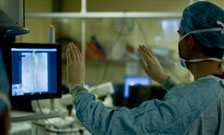Pioneering touchless surgical technology

Researchers and surgeons from King’s College London and Guy’s and St Thomas’ NHS Foundation Trust are piloting ‘touchless’ technology in the operating theatre.
The pioneering enables surgeons to view, control and manipulate medical images without contact. It is the first time the technology has been used in this way.
Developed in conjunction with Microsoft Research and Lancaster University, the software for the imaging surgery system was created by researchers from King’s Imaging Sciences department to help surgeons during complex aneurysm procedures. The computer program takes the 3D image of a patient’s anatomy, and produces several 2D images (which look like x-rays) from different view directions. The Kinect technology allows the surgeon to operate the imaging system themselves, rather than instructing an assistant to do so.
Surgeons operate in a challenging environment where they are required to maintain sterility at all times. Re-scrubbing is time consuming and therefore surgeons are frequently compelled to instruct others to manipulate visual-aid equipment for them; an often impractical and imprecise method.
This new gesture-based system uses Kinect for Windows hardware and the Kinect for Windows Software Development Kit (SDK), to allow the vascular surgery team to maintain a sterile environment, whilst being able to view and manipulate medical images through a combination of gesture and voice control.
Mr Tom Carrell, Senior Lecturer at King’s College London and vascular surgeon at Guy’s and St Thomas’, said: ‘This technology is very exciting as it allows me to easily and precisely control the imaging I need during operations. Touchless interaction means there is no compromise in the sterility of the operating field or in patient safety.’
The system is currently under trial on vascular patients at St Thomas’ Hospital with a view to expanding to the manipulation of 3D volumetric models of the brain for neurosurgery at Addenbrooke’s Hospital in Cambridge.
The ultimate aim is to develop a touchless interaction in surgery toolkit that can be used in any hospital or system interested in applying touchless interaction to their imaging system.
Dr Mark Rouncefield from Lancaster University, commented: ‘This is a lovely example of a successful interdisciplinary research project, combining the technical skills of computer scientists with a social scientific and medical expertise that ensures the new technology resonates with the way in which surgeons actually do their work.’










.jpg)

.jpg)
.jpg)





